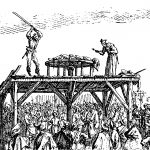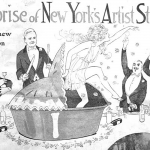Weekly Wrap Volume 89
 The Truth About Your Flammable Farts
The Truth About Your Flammable Farts
Contrary to popular belief, it’s probably not methane leaking from behind that reckless “bros” light on fire (known as pyroflatulence); rather, it’s most likely primarily hydrogen. In a typical, healthy body, human farts are comprised primarily of hydrogen, nitrogen, some carbon dioxide and potentially a small amount of methane and oxygen. These farts are primarily made in two ways – from swallowing air and digesting food. Swallowed air delivers nitrogen and oxygen to the digestive tract, where the latter is mostly, if not fully, absorbed. The nitrogen… (more)
 The Curious Tail errr, Tale of F.D.C. Willard
The Curious Tail errr, Tale of F.D.C. Willard
In the world of physics the name F.D.C. Willard is simultaneously treated with both reverence and derision. On one hand, he co-authored an often cited paper on low temperature physics at age 7 and was the sole author of another entire paper on the subject in French just a few years later at age 12. On the other hand, he was also a cat. The story of Willard’s foray into the world of low temperature physics began in 1975 when his eventual co-author, Professor Jack H. Hetherington, asked a colleague at Michigan State University to read over a paper he’d written, Two-, Three-, and Four-Atom Exchange Effects in bcc 3He. After reading over the paper… (more)
 The Origin of the Color Belt Scheme in Martial Arts
The Origin of the Color Belt Scheme in Martial Arts
White, yellow, orange, green, blue, purple and black, the colors of martial arts belts denote student development, skills and experience. However, contrary to popular belief, using colored belts to denote rank or ability in martial arts is a relatively recent invention in the otherwise ancient arts- one that was only introduced around the turn of the 20th century. Much of the common look of the modern martial art uniform, including the comfortable baggy pants and belted smock, was introduced by the founder of judo, Kanō Jigorō, who first took up jujutsu in an effort to gain strength. (At the time he first began to purse the martial art, he was only 5 feet 2 inches tall and 90 pounds.) A well-regarded teacher and polymath in his home country of Japan, Jigorō created judo… (more)
 Peter Stumpf, The Werewolf of Bedburg
Peter Stumpf, The Werewolf of Bedburg
Depending on who you want to believe, Peter Stumpf was either a severely deranged individual with an undiagnosed mental illness, a victim of the fight between Catholics and Protestants, or a werewolf acting under the command of Satan himself. Little is known about Peter Stumpf’s early life prior to his eventual confession to well over a dozen brutal murders. What we do know about Stumpf is that he was a farmer in the small German town of Bedburg in the late 16th century. Stumpf was ultimately arrested in 1589 following a purported string of brutal deaths throughout Bedburg, originally thought to have resulted from wolf attacks. Stumpf became… (more)
 What Happens When You Freeze Water in a Container So Strong the Water Can’t Expand Into Ice?
What Happens When You Freeze Water in a Container So Strong the Water Can’t Expand Into Ice?
Some readers may recall a science class in which an excitable teacher walked to the front of the class to show off a small, cracked steel container, seemingly damaged by an incredibly powerful, but tiny force; only for said teacher to reveal that the damage had been done by nothing more than water. However, what would happen if you put the water in a container it couldn’t break out of and then froze it? The short answer is that the water still turns into ice; however, if it genuinely cannot break the bonds of the container it is trapped inside, it turns into a very different kind of ice than we’re used to seeing. We currently know of 15 different “solid phases” of water, aka ice, with each type… (more)
This Week’s YouTube Videos:
- Why Pluto was Named by an 11 Year Old Girl
- Teflon was Invented by Accident
- Removing People From History (Damnatio Memoriae)
- Why Figure Skaters Don’t Seem Dizzy After Spinning
- How do Smoke Detectors Work
- The Tallest Man Ever… and 9 other Amazing Records
- Why we Throw Coins into Fountains
- Why a Bakers Dozen is 13 Instead of 12
Bonus Quick Facts:
- Along with the fact that eating KFC at Christmas is a tradition in Japan, Colonel Sanders is somewhat of a cult figure there. Not only is there a life-sized statue of the Colonel in front of most KFCs in Japan, but his memorabilia, like wind-up toys and figurines, can be found at many toy stores throughout Japan.
- The name “tetris” derives from the Greek prefix “tetra-” (because the game pieces are all tetrominoes) and the latter “-is” is from “tennis”, which is the primary creator of Tetris, Alexey Leonidovich Pajitnov’s, favorite sport. Tetrominoes are four element polyominoes. Polyominoes are known to have been used in puzzle games for at least 90 years (and most likely much further back than that) at the time Pajitnov developed Tetris at the Dorodnicyn Computing Center, which was a part of a Soviet government funded research center in Moscow, called the Soviet Academy of Sciences. (The fact that he created it there is also why the Soviet Union owned the rights to the game for quite some time after its creation.)
- Applying Super Glue (cyanoacrylate) to cotton or wool results in a rapid chemical reaction that releases enough heat to cause minor burns, so typically this should be avoided. However, if enough cyanoacrylate is added to the cotton or wool, the fabric will catch on fire, making this a great trick to keep in mind in survival situations.
- Menthol can be used in solid form as a substitute for real ice. As far as your brain is concerned, the beverage you drink with the menthol is cold, even though it might actually be warm. This makes for handy “icing” of your drinks on camping trips.
- LEDs are much more efficient than “regular” incandescent light bulbs due to the fact that they give off very little heat; so a much higher percentage of the electricity used goes towards making light, rather than in incandescent bulbs where a good percentage of it ends up being converted to heat.
- Myth: Velcro was invented by NASA for the space program. In fact, Velcro was already commercially available before being used by NASA. It did receive a huge boost in popularity after being used by NASA on parts of astronaut’s space suits as well as used to allow astronaut’s to store things along the walls of their space craft. Because of this, similar to Tang, it is a common misconception that Velcro was invented by or for NASA.
Other Interesting Stuff:
When Sir Arthur Conan Doyle first began writing Sherlock Holmes stories back in the late 19th century, 221B Baker Street didn’t exist. While Baker Street itself existed, and still exists today, the numbers on the street back when Doyle wrote the Sherlock Holmes novels and when Holmes was supposed to reside there (1881 to 1904 according to Doyle’s original stories) only went into the hundreds. It would seem that Doyle intentionally picked an address that didn’t exist. This all changed in the 1930s when the street numbers in London were rejigged and reallocated to make things a little more streamlined. During the reallocation, a recently constructed building for the Abbey Road Building Society (aka Santander), known as “Abbey House” was awarded all of the odd numbers between 219 and 229. Because the address… (more)
 Top 5 First Aid Tricks Everyone Should Know
Top 5 First Aid Tricks Everyone Should Know
In my profession as a paramedic / firefighter one question repeatedly gets asked of me- “What are some simple first aid tricks to know in case of an emergency?” As such, I thought it would be a good idea to do a little article series on the subject. This will be a 5 part series published throughout this week on the Top 5 First Aid Tricks Everyone Should Know. The obvious question arises, according to whom? The top 5 of almost anything will always be subjective. In this case, for example, someone with diabetes might think giving insulin should be the #1 “trick”, while someone who just broke their ankle might think pain relief should be #1. These top 5 are not the top five medical conditions that can kill you and how to treat them, but 5 easy to do first aid things that anyone can perform- being able to perform them will allow you to save someone’s life, and knowing them will help in a wide range of situations. With this in mind, I used my own expertise and polled numerous paramedics and doctors in the emergency system I work, and came up with… (more)
 How Did the Practice of Women Jumping Out of Giant Cakes Start?
How Did the Practice of Women Jumping Out of Giant Cakes Start?
Almost everyone has seen depicted the bizarre bachelor party tradition of a scantily-clad woman jumping out of a giant cake. It turns up most often in decades-old films, TV shows, and comics, but it still persists today at lavish Vegas shindigs—though the cakes are now usually made of flimsy cardboard. Younger folks may have first encountered the ritual via The Sims: House Party, in which the player could buy a huge cake, then choose a command to hire an entertainer. If you’re thinking it’s a tradition that dates back to the swanky cocktail-fueled, pre-feminist Mad Men era, you’re only partly correct- humans have been putting odd things in their food for entertainment purposes for centuries. No one threw a dinner party like the Ancient Romans did, and they may have been the first to seriously combine food and entertainment; that is, the food often was also the entertainment. Wealthy banquet-throwers tried to outdo one another with exotic dishes, serving up peacocks, ostriches, dormice, and rare songbirds. Stuffing… (more)
 A Brief History of the Ballpoint Pen and Whether NASA Really Spent Millions Developing a Pressurized Version Instead of Just Using Pencils
A Brief History of the Ballpoint Pen and Whether NASA Really Spent Millions Developing a Pressurized Version Instead of Just Using Pencils
The humble ballpoint pen is an item so ubiquitous the chances of you not having one near you right now are so low E.T could probably give you the percentage on his right hand. Few people realize just how much technology, craftsmanship and effort goes into creating a single pen- probably because you can buy 30 of them for a few dollars, only to mysteriously have them all disappear within a week. As the name would suggest, ballpoint pens work by utilizing tiny metal ball bearings. In the case of the most famous ballpoint pens of all, Bic, the ball is commonly made from tungsten carbide, which is notably the same material often used to make armour piercing bullets. After the material has been shaped, it’s then highly polished in a machine that uses a paste made from diamonds. Yes… (more)
 When People Started Burning Books
When People Started Burning Books
To a writer, a bookworm, or a believer in the freedom of press and knowledge, there is nothing quite as horrifying as hearing about piles of books getting eaten by flames, never to be read again, particularly in instances in history where some of the books being burned were extremely rare and since lost to us other than passing references in surviving works. Book burning is one of the most extreme forms of censorship, suppressing opposing views to religious and secular authorities by ceremoniously burning written text. Unfortunately, book burning has a long history and the practice is still very much alive today, despite the ironic nature of what it accomplishes now vs. in the past when the books in question were rare. One of the earliest references of an intentional “book” burning comes from a story in the Bible (Jeremiah 36) in which Jehoiakim… (more)
 Setting Fire to Glass- The “Nope” Chemical That is Chlorine Trifluoride
Setting Fire to Glass- The “Nope” Chemical That is Chlorine Trifluoride
First discovered back in the 1930s, chlorine trifluoride is a rather curious chemical that easily reacts, sometimes explosively, with just about every known substance on Earth. Just to get the ball rolling, here’s a few of the more unusual things chlorine trifluoride is known to set fire to on contact: glass, sand, asbestos, rust, concrete, people, pyrex, cloth, and the dreams of children… Obviously the first question to answer here is how chlorine trifluoride is somehow able to cause asbestos, a substance that is known for being almost completely fire retardant, to catch on fire. Well, that’s because chlorine trifluoride is a more powerful oxidizing agent by mass than oxygen itself. Meaning it’s capable of rapidly oxidizing things that would normally be considered practically “impossible” to set aflame… (more)
| Share the Knowledge! |
|






One comment